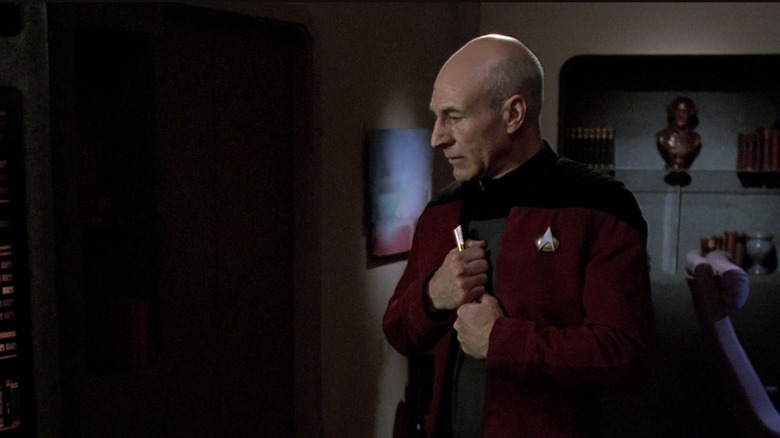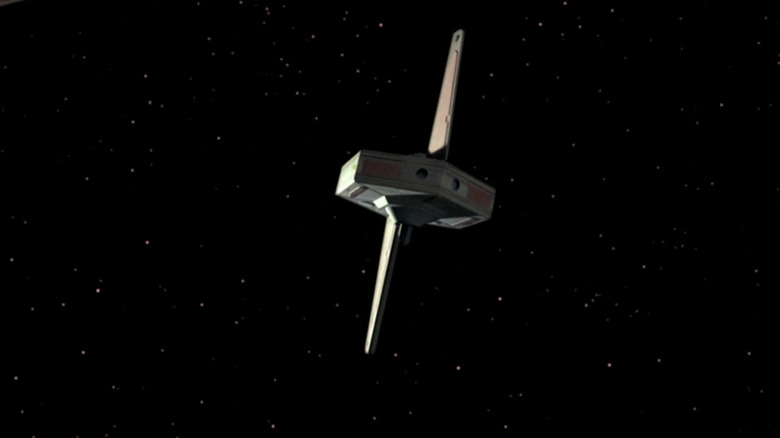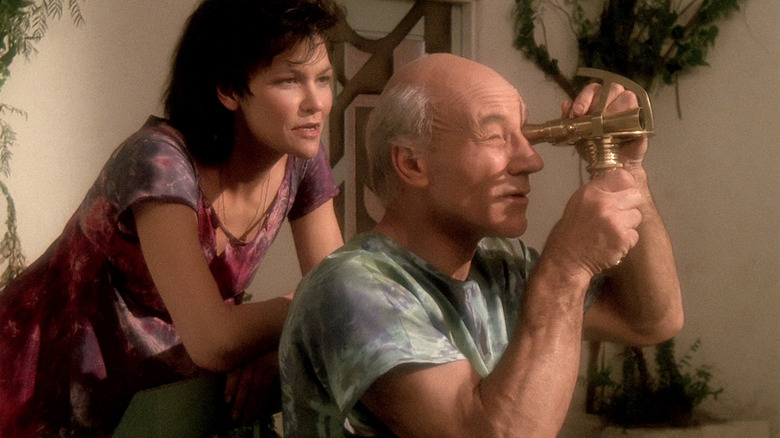Star Trek: The Next Generation Scrapped A Sequel To One Of Its Best Picard Plots
"The Inner Light" (June 1, 1992) is handily one of the best episodes of "Star Trek: The Next Generation." The events of the episode are so dramatic that it's a little unusual that Captain Picard (Patrick Stewart) didn't bring them up more often in future episodes of the show. Indeed, in the third season of "Star Trek: Picard," the retired admiral mentions that he's finally ready to be a father and let the next step of his life unfold, failing to acknowledge that he already lived to be an old man, already raised his own children and grandchildren, and already fell deeply in love with an alien woman on a distant planet where he lived for many decades. Never mind that it was all a memory implant given to him by a rogue space probe.
The events of "The Inner Light" dictated that Picard essentially has two lifetimes worth of memories crammed into his head. Perhaps that was the source of his Irumodic Syndrome. At the end of the episode, Picard finds that he recalls his abilities to play the Kataan flute, complete with all the tunes he learned over a lifetime of folk performance. The flute will come back in future episodes of "Next Generation," but Picard's deeply moving journey growing to old age, even if artificial, is never mentioned again. Not even a note along the lines of "I know what it feels like to get old. I was 100 once before."
In the oral history book "The Fifty-Year Mission: The Next 25 Years: From The Next Generation to J. J. Abrams," edited by Mark A. Altman and Edward Gross, the episode's credited story writer, Morgan Gendel, recalled his inspiration for the episode, but also a follow-up episode that, he hoped, would be just as emotionally devastating.
'The Inner Light'
The plot of "The Inner Light" sees Picard encountering the above-mentioned mysterious probe out in deep space. The probe shoots a glimmer of light into Picard's brain and he passes out on the floor. He is awakened on the distant planet Kataan by a woman named Eline (Margot Rose) who claims to be his wife. She tells Picard that his name is actually Kamin and that he is a humble ironmonger. Picard rejects this information at first but slowly, as the weeks pass, begins to appreciate the blissful agrarian life on Kataan.
He lives on Kataan for many years, accepting his new role and finding the kind of domestic happiness being a captain never afforded him.
When Picard was about 100 years old, the truth was finally revealed to him. It seems the whole of the Kataan people were wiped out by a supernova many, many years ago. The probe was launched as a last-ditch effort to keep the memory of the Kataan people alive, containing a memory "recording" of Kamin's life. The probe would find a host out in space and beam a cultural experience directly into the brain of a passing alien. Picard was their vessel. Picard awakens back on the bridge of the Enterprise. Only 25 minutes had passed.
Gendel's original idea for the episode skewed in a more Philip K. Dick direction. He said:
"My original idea involved this ship that would zap this interactive thing into mind and puts you in a different place. Instead of advertising 'come to Maui,' you find yourself on a beach somewhere else. That was my original thought. I really liked the notion of an alternate reality, so when I went in to pitch a probe zapping their brains, I came up with an antiwar message."
The antiwar message
While zapping a VR advertising message directly into a human brain is a fine story for a dystopian, Terry Gilliam-like film, an antiwar message is more appropriate for the notoriously pacifist "Star Trek." Still, initially, Gendel wanted the story to be much darker, depicting a war that wiped out a whole planet a generation ago. He recalled:
"I thought, what if some civilization had been through some terrible war and didn't want others to repeat it? So Picard and Riker are hit with the probe and find themselves on a planet with stormtroopers coming and they had to finish the story to get back to the Enterprise. It seemed entirely real to them while they were there, and they had to escape these marching soldiers and a war, which was leading up to a nuclear holocaust. Meanwhile, aboard the ship, they're in comas."
More than anything, Gendel wanted the "virtual reality" element of his story to remain. He liked the idea of a comatose person having a whole, full life inside their own brains. Gendel met with his co-screenwriter Peter Allan Fields, the series executive story editor, and they started to spitball further, brainstorming ideas about how Picard and Ensign Ro (Michelle Forbes) would be beamed into an alternate realm where they might marry (!).
It was executive producer Michael Piller who made the call that Picard should be alone in his VR experience and that he should fall in love with a virtual family inside the simulation. Gendel said that "[t]hat's where the heart of the story was, with him leading this other life. Michael rightfully said, 'We're not going to need to cut back to the ship that much. The story is going to be with Picard.'"
The life Picard never had
Piller also removed the "war" aspect, with Kataan's extinction being due to a natural phenomenon. "The Inner Light" became a character piece rather than a war commentary.
Picard had stated numerous times throughout "Next Generation" that he was no family man, never wanted children, and had difficulty with maintaining romantic relationships because of his job as a Starfleet captain. "The Inner Light," Fields noted, was transformed into something of a wish-fulfillment fantasy for the character. Picard was finally removed from his familiar surroundings and forced to settle down. As it so happens, he took to it well.
Gendel liked the finished teleplay and even had a tragic idea for a follow-up. Picard assumed that the planet of Kataan was wiped out many years ago. What if, Gendel posited, it wasn't that long ago, and Picard could meet the woman he fell in love with in the simulation ... in person? Gendel said:
"Picard was married to this woman, made love to her, and grew old with her, so it's not like a dream. It's real to him, and now his dead wife has come back to life, which is a really powerful thing and made more so by the fact she doesn't know who the hell he is. And she's married to one of the scientists also on board the probe. I have a personal attachment to this episode, and I thought my passion for that would get it through."
Gendel felt that "the idea is so powerful. His whole family has been destroyed in a natural holocaust, a nova explosion, and now he finds out his wife is alive." But, it seems, "The Inner Light" became so beloved, the Trek showrunners were happy to leave well enough alone.
Perhaps someday, Kataan will return.



